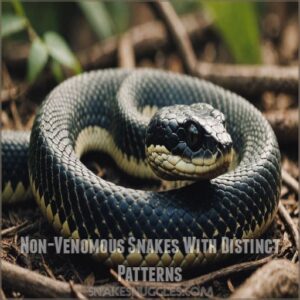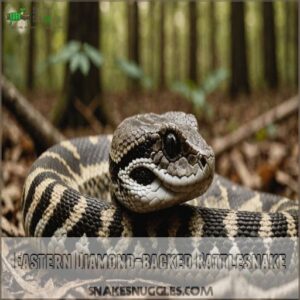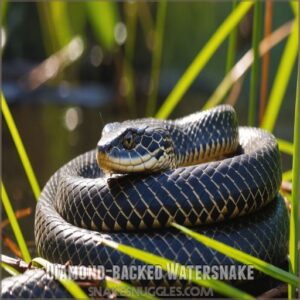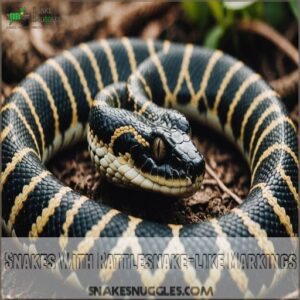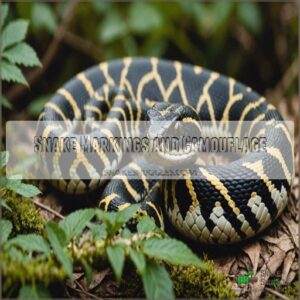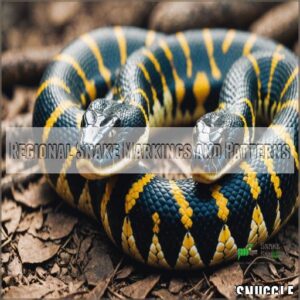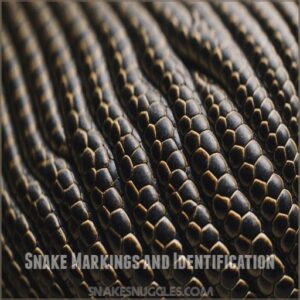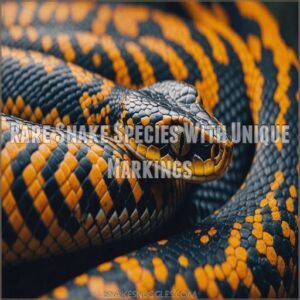This site is supported by our readers. We may earn a commission, at no cost to you, if you purchase through links.
 When you think of snake species with unique markings, the Eastern coral snake might slither to mind.
When you think of snake species with unique markings, the Eastern coral snake might slither to mind.
Its bright red, black, and yellow bands are similar to a vibrant carnival outfit.
These colors aren’t just jaunty—they scream, "Stay back, I’m venomous!"
Meanwhile, the green tree python boasts a jewel-like brilliance, its emerald scales dotted with white or blue.
It’s like a living piece of art hanging out in trees.
Each snake’s markings aren’t just for show; they’re tools for camouflage, warning, or attracting prey.
Stick around as we unwrap more fascinating features that transform these reptiles into masters of disguise.
Table Of Contents
- Key Takeaways
- Venomous Snakes With Unique Markings
- Non-Venomous Snakes With Distinct Patterns
- Snake Pattern Types and Meanings
- Snakes With Diamond Patterns
- Snakes With Rattlesnake-like Markings
- Snakes With Copperhead-like Markings
- Snake Markings and Camouflage
- Regional Snake Markings and Patterns
- Snake Markings and Identification
- Rare Snake Species With Unique Markings
- Frequently Asked Questions (FAQs)
- Which snake has a uniform pattern?
- How do you identify a snake?
- What is a snake pattern?
- What snakes have diamond patterns?
- How do I identify a snake I found?
- What is the most rare species of snake?
- What snake has markings like a rattlesnake?
- What snake looks like a copperhead but isn’t?
- How do snake markings affect behavior?
- Can snake markings indicate age or sex?
- Do markings influence snake diet preferences?
- How do markings evolve in different environments?
- Are snake markings used for communication?
- Conclusion
Key Takeaways
- You’re likely to recognize snakes by their vibrant markings, which aren’t just eye-catching but serve vital roles in camouflage, defense, and even attracting prey.
- Venomous snakes like the Eastern and Western Diamond-backed Rattlesnakes have distinctive patterns that help them blend into their habitats while warning potential predators. Non-venomous snakes like the Gopher Snake, which is often confused with the rattlesnake due to its similar markings and behavior.
- Non-venomous snakes often use mimicry to their advantage, displaying rattlesnake-like markings as a defense mechanism against predators.
- Snake markings vary by region and environment, evolving to aid in survival; from the forests to the deserts, these patterns help them stay hidden or communicate effectively.
Venomous Snakes With Unique Markings
When you encounter venomous snakes with unique markings, like the diamond patterns on rattlesnakes, you’re seeing nature’s artwork with a purpose.
These distinct features help snakes blend into their surroundings but also provide key identification cues for your safety.
Eastern Diamond-backed Rattlesnake Patterns
Recognizing Eastern Diamond-backed Rattlesnake patterns is key to safe identification.
You’ll notice their iconic diamond-shaped markings, varying in intensity and size.
These rattlesnake variations depend on geographic differences and even individual snakes.
You can find fascinating information about snake markings, like those of the Eastern Diamond-backed Rattlesnake, on this website.
This camouflage effectiveness helps them blend into their surroundings.
Understanding these patterns improves your ability to identify this venomous snake species and enhances your safety.
Remember, defensive strategies are essential!
Western Diamond-backed Rattlesnake Characteristics
Just after marveling at the Eastern Diamond-backed’s bold patterns, you might be curious about the Western Diamond-backed Rattlesnake.
This fascinating snake boasts diamond-shaped markings that catch the eye.
Living mainly in arid habitats, they prey on small mammals.
With potent venom and cautionary rattles, their behavior isn’t aggressive unless threatened.
Identifying them becomes an intricate yet rewarding endeavor!
Timber Rattlesnake Identification
While the Western Diamond-backed Rattlesnake‘s bold patterns capture attention, the Timber Rattlesnake offers its own unique identification challenges, often returning to the same refuge each year.
Look for distinct dark crossbands on a lighter background, often with a rust-colored stripe along its back.
This snake prefers wooded habitats, showcasing behavior suited for ambush.
Despite its venom, the timber rattlesnake plays a key role in controlling rodent populations.
Prairie Rattlesnake Markings
From the timber rattlesnake’s distinct patterns, you’ll now spot the prairie rattlesnake’s unique markings across American prairies.
Their markings tell a story of evolution, age, and diet.
Look for:
- Color Variations: Shades vary by region, adapting to the environment.
- Band Patterns: These bands offer regional diversity in appearance.
- Age Markings: As they age, their markings evolve, displaying a lively tale.
Non-Venomous Snakes With Distinct Patterns
Among non-venomous snakes, vibrant patterns are nature’s canvas.
You might even spot a Northern Watersnake or a Queen Snake, each boasting unique designs that make them stand out in their habitats.
Northern Watersnake Patterns
Moving from venomous snakes to the charming Northern Watersnake, you’ll notice how its varied patterns can stump even seasoned identifiers.
Don’t let its non-venomous nature lull you—its intricate stripe and blotch design serves a purpose.
Northern Watersnake Coloration isn’t just for show; it aids in blending with riverbanks.
Spotting these markings sharpens your animal identification skills!
Plain-bellied Watersnake Characteristics
Consider the Plain-bellied Watersnake, your typical non-venomous neighbor with distinct markings, which can be confused with the red-bellied water snake, a species that thrives in aquatic habitats, showcasing a preference for calm waters.
This snake’s behavior includes hunting amphibians and small fish, essential for its diet.
With keen senses and a smooth texture, it navigates effortlessly.
Their reproduction involves live birth, and conservation efforts focus on habitat preservation for this fascinating species.
Queen Snake Identification
Let’s move on to another fascinating non-venomous snake: the Queen snake. These snakes are easily identified by their unique markings. You’ll find them in various habitats, and their diet primarily consists of aquatic creatures. Their behavior is often shy and secretive.
Here are some key features to look for:
- Distinct dorsal pattern.
- Smooth scales.
- Slender body shape.
- Relatively small size.
Queen snake conservation efforts are important for maintaining their populations. Their range includes various parts of North America. Don’t confuse them with kingsnakes or milk snakes!
Snake Pattern Types and Meanings
When you’re exploring the realm of snakes, paying attention to their patterns can be both fascinating and educational.
Stripes, spots, and bands aren’t just for show; they serve important roles in camouflage and communication, making each snake unique in its own right.
Stripe Patterns in Snakes
Stripe patterns on snakes, like a natural barcode, tell a tale of survival.
Imagine them as nature’s camouflage, helping the snake species avoid predators.
These patterns vary across snake families, influenced by evolution and geographic variation.
Importantly, coral snakes and their non-venomous counterparts, like the milk snake, display distinct red and yellow bands, but with a key difference – Coral snake vs milk snake.
| Stripe Types | Snake Species | Adaptation Purpose |
|---|---|---|
| Vertical | Garter Snake | Camouflage |
| Horizontal | Kingsnake | Warning markings |
| Zigzag | Asian Water Snake | Movement confusion |
| Single Stripe | Eastern Coral Snake | Mimicry |
Spot Patterns in Snakes
Curious about spot patterns in snakes? These unique markings add to their allure and serve essential functions. They aid in snake camouflage, confuse predators, and help with spot pattern identification among species like Colubridae and Viperidae.
Spot patterns may seem like simple dots, but they reflect adaptive changes through spot pattern evolution. They’re nature’s subtle storytellers!
- Spot pattern variations
- Snake camouflage
- Spot pattern function
- Spot pattern identification
Band Patterns in Snakes
Spot patterns tell a tale of stealth, but let’s chat about band patterns now.
Band patterns in snakes offer unique insights into their biology, acting as camouflage and indicating evolutionary adaptations.
These bands can vary in color and width, often signifying venomous traits.
Each snake species flaunts its markings, making herpetology a fascinating field to master.
Snakes With Diamond Patterns
You’ll often spot the unique diamond patterns on snakes like the Eastern and Western Diamond-backed Rattlesnakes, as well as the Diamond-backed Watersnake.
These patterns make them stand out but also provide them with excellent camouflage in their natural habitats, which is a clever way to stay hidden from both predators and prey.
Eastern Diamond-backed Rattlesnake
Imagine walking through the forest and spotting the formidable Eastern Diamond-backed Rattlesnake.
Known for its distinct diamond patterns, this species is native to the southeastern United States.
These rattlesnakes prefer sandy woodlands and coastal habitats, feeding on small mammals.
Be cautious of its potent venom, but don’t forget that they play a key role in controlling rodent populations.
Western Diamond-backed Rattlesnake
Now that you’ve learned about the Eastern Diamondback, let’s meet its western cousin!
The Western Diamondback Rattlesnake (Crotalus atrox) boasts a similar diamond pattern, but its habitat stretches across the southwestern US.
Its venom is potent, making snake education essential.
You’ll find these snakes in diverse environments, preying on rodents and rabbits.
Understanding their behavior and conservation status is key to safe co-existence.
Remember, size and shape vary, but their distinctive markings help with identification.
Misconceptions about these snakes are common; accurate knowledge reduces fear.
Diamond-backed Watersnake
Moving from the Western Diamond-backed Rattlesnake, you encounter the Diamond-backed Watersnake.
Living in aquatic habitats, this non-venomous snake thrives near lakes and rivers.
You might find it humorous how often it mimics venomous species to avoid predators.
Keep these tips handy:
- Habitat: Lakes and rivers
- Diet: Fish and amphibians
- Behavior: Mimicry and stealth
Snakes With Rattlesnake-like Markings
When exploring snakes with patterns similar to those of their venomous counterparts, it’s interesting to note that bullsnakes and gophersnakes, including the Sonoran Gophersnakes in Arizona, have developed unique markings to deter predators. As you explore snakes with rattlesnake-like markings, you’ll find remarkable mimics like bullsnakes and gopher snakes, which sport patterns that often fool predators—and sometimes humans.
By identifying these patterns, such as rings and banding, you gain valuable skills in distinguishing these harmless mimics from their venomous counterparts.
Bullsnake Patterns
While diamond patterns are eye-catching, bullsnakes offer a fascinating look with their rattlesnake-like markings.
These snakes use mimicry for protection, sporting dark blotches against light backgrounds to confuse predators.
Bullsnake markings vary by region, adding a colorful twist to their identity.
Despite their fierce appearance, bullsnakes play a role in pest control, making them beneficial in their habitats.
Gopher Snake Characteristics
Think you spot a rattlesnake? It might just be a gopher snake playing tricks.
Gopher snakes, with their Boidae-like build, are masters of mimicry.
These non-venomous snakes imitate rattlesnakes by:
- Vibrating their tails
- Flattening their heads
- Hissing loudly
- Adopting similar markings
They inhabit diverse areas but avoid copperhead territories.
Understanding these clever creatures helps you respect their role in the ecosystem.
Pine Snake Identification
Gopher snakes surely intrigue with their patterns, yet pine snakes take mimicry to another level with rattlesnake-like markings.
Their habitat spans sandy pine forests, offering perfect camouflage.
They’re non-venomous, so don’t let their looks fool you.
Pine snakes mainly eat small mammals.
For conservation, protecting their habitat is key.
Keeping them away is easier with natural snake repellents.
Snakes With Copperhead-like Markings
Exploring snakes with Copperhead-like markings, you’ll find fascinating evolutionary adaptations.
These mimicry tactics can confuse predators and protect look-alikes, like the Northern Watersnake, from potential threats.
A closer examination of their coppery hues and patterns, often featuring hourglass-shaped crossbands, reveals the art behind their markings, which sometimes mirror those of the venomous Copperheads found in wooded areas and rocky hillsides near streams copperhead snake identification.
These imposters use regional variations in their patterns, making them true masters of disguise.
A closer look reveals the art behind their markings, which sometimes mirror the coppery hues of their venomous counterparts.
Ball pythons, boa constrictors, and even Burmese pythons might surprise you with their mimicry skills too, showcasing non-venomous look-alikes.
As you wander through forests and fields, remember: these snake markings tell a tale of evolution.
Recognizing these patterns is like solving a puzzle, each piece revealing the intricate dance of survival in the wild.
Snake Markings and Camouflage
You’ll discover how snake markings aren’t just pretty patterns; they’re essential for survival, acting as camouflage in diverse habitats.
We’ll explore how different snake species use their colors and designs to blend seamlessly into their surroundings, from forests and deserts to waterways.
Forest Snakes and Camouflage
After exploring patterns akin to the Copperhead, let’s consider forest snakes and their knack for camouflage.
Blending seamlessly into the forest floor, these reptiles have perfected mimicry patterns.
Their behavior showcases the intricate dance of predator-prey dynamics.
Whether you’re an anaconda admirer or battling snake phobia, understanding camouflage evolution aids both wildlife insight and reptile conservation.
Desert Snakes and Camouflage
Picture the desert, where snakes use sand-colored scales to blend seamlessly with their arid surroundings.
Their coloration strategies are as impressive as a master illusionist’s tricks, helping them avoid predators and sneak up on prey.
These adaptations are essential for survival, contributing to the ecosystem balance and reducing the risk of snake bites, all while supporting wildlife conservation efforts.
Aquatic Snakes and Camouflage
While desert snakes fade into sandscapes, aquatic ones master the art of blending beneath the waves.
Imagine spotting these water wonders:
- Norther Watersnakes with bold, banded patterns.
- Plain-bellied Watersnakes disappearing against muddy bottoms.
- Queen Snakes using sharp, sleek stripes underwater.
These patterns aren’t just for show; they’re about stealth and staying hidden.
Regional Snake Markings and Patterns
When exploring regional snake markings and patterns, you’ll notice distinct motifs across different parts of the country.
Whether it’s the Eastern snakes’ bold stripes, the Western serpents’ unique spots, or the Southern species’ intricate bands, understanding these patterns can help you identify the incredible diversity among snakes.
Eastern Snake Patterns
Start identifying Eastern snake patterns by focusing on color variations and mimicry traits.
Stripes, evolving through generations, help these snakes blend into forest floors or leafy backdrops.
Mimicking venomous species offers an incredible survival tactic, ensuring quicker retreats from potential threats.
Understanding these markings helps with conservation but also enriches your knowledge of their fascinating evolution and adaptations.
Western Snake Patterns
Sliding from eastern remnants into the world of western diversity, snakes in this region showcase intriguing patterns.
Western snake mimicry is brilliant; think of the bullsnake echoing rattlesnake warnings.
Evolution here paints vibrant backdrops—stripes, blotches, and surprises.
These adaptations highlight the beauty of western snake conservation efforts.
Yet, watchful eyes must consider western snake threats, safeguarding these ecological wonders.
Southern Snake Patterns
Often, Southern snake patterns are surprisingly diverse! You’ll find incredible color variations, influencing camouflage and mimicry.
To identify them, consider these key features:
- Body shape and size.
- Head shape and markings.
- Scale type and arrangement.
- Specific color patterns.
Southern snake evolution has led to fascinating adaptations, impacting their survival and conservation efforts.
Understanding these patterns is key to appreciating Southern snake folklore and protecting these creatures.
Snake Markings and Identification
You’ll find that identifying snakes starts with simple clues like body patterns, head shapes, and scales.
Think of it like spotting a friend’s favorite t-shirt in a crowd—practice makes perfect!
Body Patterns and Identification
Exploring snake patterns, you’ll find them as varied as fingerprints.
Stripes, spots, and bands aren’t just fashion choices; they’re keys to revealing nature’s mimicry and adaptation.
With these patterns, snakes play the survival game, evolving to blend in or stand out, depending on their habitat.
Regional differences mean identification is no picnic, often challenging even seasoned herpetologists.
Head Shape and Identification
When identifying snakes, head shape reveals much.
A triangular head shape is often linked to venomous species, but don’t fall for myths—some non-venomous snakes sport similar heads.
Rounded heads usually indicate harmless snakes.
Over time, head shape evolution has honed these differences.
With practice, you’ll see how head shape variations play a key role in snake identification.
Scales and Identification
After examining head shapes, turn your gaze to scales, a key clue in snake identification.
Scale types, like smooth or keeled, affect movement and appearance.
Many species showcase distinctive patterns, such as those found on products with snake patterns, which help camouflage and offer insights into a snake’s habitat and behavior.
From scale function to variation and evolution, these tiny features pack a powerful punch in mastering the art of snake identification.
Rare Snake Species With Unique Markings
You’ll discover some of the rarest snake species featuring unique markings that set them apart in their habitats.
From the striking patterns of the Eastern Indigo Snake to the vivid hues of the Sonoran Coralsnake, these snakes offer a fascinating glimpse into nature’s artistry.
Eastern Indigo Snake Patterns
An Eastern indigo snake’s stunning color variations display rich, glossy patterns that seem to mimic a midnight sky.
You’ll find them in diverse habitats, blending in seamlessly.
They’re important for conservation as they help maintain balance in their ecosystems.
Observing their behavior, you notice how calm and curious they are—almost as if they’re ready to teach us their secrets.
Just like the eastern king snakes species profile, Eastern indigo snakes are also highly adaptable and exist in a wide range of ecosystems.
- Indigo sheen varies
- Non-venomous nature
- Key in snake conservation
- Live in wooded areas
- Calm disposition
Western Coral Snake Characteristics
With their striking beauty, Western Coral Snakes command attention.
You’ll find them in diverse habitats, from deserts to grasslands.
Their diet consists mainly of lizards and other snakes.
Western Coral Snake venom is potent, so admire them from a distance!
Mimicry is key to their survival.
Conservation efforts are essential for these rare reptiles.
| Characteristic | Detail | Importance |
|---|---|---|
| Habitat | Southwestern US, Mexico | Influences prey availability, survival |
| Diet | Lizards, other snakes | Essential for energy, growth |
| Venom | Highly toxic | Defense mechanism, essential for survival |
Sonoran Coralsnake Identification
You’ve heard about the Western Coral Snake, let’s meet its Sonoran cousin.
Identifying the Sonoran Coralsnake involves sharp eyes and a quick mind.
These snakes flaunt bright bands—a masterclass in mimicry.
They’re shy, preferring sandy deserts, so watch your step and your sandals!
If you’re fascinated by rare species like the Sonoran Coralsnake, check out rare snake products.
Remember:
- Avoid sudden movements.
- Seek first aid after bites.
- Support conservation.
- Stay informed on venom toxicity.
Frequently Asked Questions (FAQs)
Which snake has a uniform pattern?
Approximately 3,000 species of snakes exist worldwide, but the Eastern Indigo Snake stands out with its glossy, uniform blue-black pattern.
This visually striking appearance makes it uniquely easy to recognize among other snake species.
How do you identify a snake?
Spotting a snake involves checking its color, body patterns like stripes or spots, and head shape.
Triangular heads often hint at venomous snakes.
Observing these traits gets easier with practice, much like recognizing familiar faces.
What is a snake pattern?
Imagine snakes wearing designer outfits, flaunting stripes, spots, and bands.
Snake patterns refer to these unique markings on their skin.
Snake patterns aid in camouflage, identification, and, occasionally, scaring off those who dare approach too closely.
What snakes have diamond patterns?
Several North American snakes boast diamond patterns. Rattlesnakes like the Mojave Rattlesnake and Western Diamondback display distinctive diamond-shaped patterns. Eastern and Western Diamondback Rattlesnakes are prime examples. Their markings help them blend into their environment. Remember, accurate identification requires careful observation.
How do I identify a snake I found?
A snake’s like a cryptic puzzle.
Look at its body patterns, head shape, and scale texture.
Triangular heads often signal venom, while round heads usually mean it’s harmless.
Don’t forget to check local species guides for more clues.
What is the most rare species of snake?
The rarest snake species is often considered the Saint Lucia racer, with fewer than 20 individuals in the wild.
It faces threats like habitat destruction.
This gentle snake’s struggle highlights the incredible diversity and vulnerability of nature.
What snake has markings like a rattlesnake?
You might say a corn snake copies the rattlesnake’s style, flaunting brownish-red blotches on its back.
While it lacks the rattle and venom, its similar markings can trick predators into thinking twice before attacking.
What snake looks like a copperhead but isn’t?
A snake that resembles a copperhead but isn’t is the Eastern Milk Snake.
It has similar hourglass-shaped bands but is harmless.
Over time, you’ll learn to spot subtle differences—it’s like recognizing an old friend!
How do snake markings affect behavior?
Around 30% of snakes use markings for camouflage, helping them blend into environments and evade predators.
Stripes, spots, and bands often mimic local foliage or shadows, modifying their behavior by reducing visibility and enhancing hunting success.
Can snake markings indicate age or sex?
Snake markings typically don’t indicate age or sex directly.
Instead, factors like body size or head shape might give clues.
Certain species have subtle sexual dimorphisms, like size differences, but markings remain consistent throughout life.
Do markings influence snake diet preferences?
Don’t you wonder how a snake’s markings affect its hunting?
No direct link exists between a snake’s markings and its diet.
Markings primarily aid camouflage and species identification, not food choice.
A snake’s diet depends on its size and habitat.
How do markings evolve in different environments?
Markings in snakes evolve as camouflage in diverse habitats, offering protection from predators.
In deserts, they mimic sand patterns, while forest snakes develop earth-toned scales.
These adaptations improve survival by blending seamlessly into their environments.
Are snake markings used for communication?
Yes, snake markings often help communicate threats or mating readiness to other animals.
These visual cues warn predators to steer clear or attract partners.
It’s like wearing a flashy outfit to get noticed, but with survival stakes.
Conclusion
Picture snake species with unique markings as nature’s canvas—each pattern a stroke of evolutionary genius.
With vibrant colors or subtle shades, these markings aren’t just beautiful; they’re essential for survival.
Whether it’s warding off predators or blending into habitats, every snake tells a story through its skin.
By learning about these fascinating reptiles, you gain insight into their world.
Embrace the wonder of snakes and remember, the next surprise might be right under your feet.


